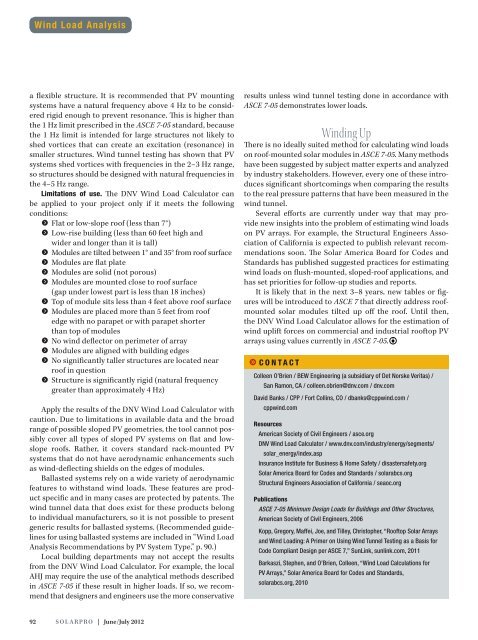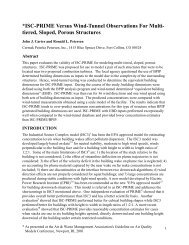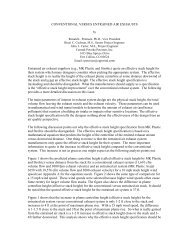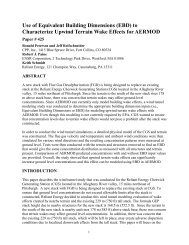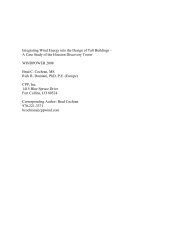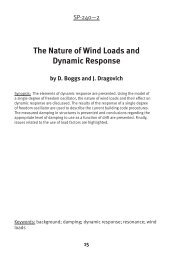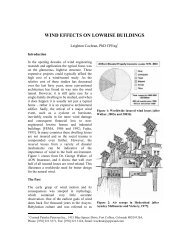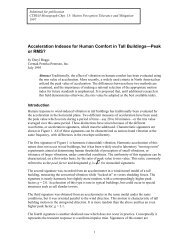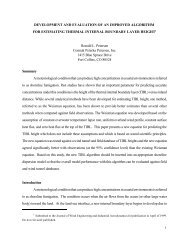Wind Load Analysis - CPP
Wind Load Analysis - CPP
Wind Load Analysis - CPP
Create successful ePaper yourself
Turn your PDF publications into a flip-book with our unique Google optimized e-Paper software.
<strong>Wind</strong> <strong>Load</strong> <strong>Analysis</strong><br />
a flexible structure. It is recommended that PV mounting<br />
systems have a natural frequency above 4 Hz to be considered<br />
rigid enough to prevent resonance. This is higher than<br />
the 1 Hz limit prescribed in the ASCE 7-05 standard, because<br />
the 1 Hz limit is intended for large structures not likely to<br />
shed vortices that can create an excitation (resonance) in<br />
smaller structures. <strong>Wind</strong> tunnel testing has shown that PV<br />
systems shed vortices with frequencies in the 2–3 Hz range,<br />
so structures should be designed with natural frequencies in<br />
the 4–5 Hz range.<br />
Limitations of use. The DNV <strong>Wind</strong> <strong>Load</strong> Calculator can<br />
be applied to your project only if it meets the following<br />
conditions:<br />
f Flat or low-slope roof (less than 7°)<br />
f Low-rise building (less than 60 feet high and<br />
wider and longer than it is tall)<br />
f Modules are tilted between 1° and 35° from roof surface<br />
f Modules are flat plate<br />
f Modules are solid (not porous)<br />
f Modules are mounted close to roof surface<br />
(gap under lowest part is less than 18 inches)<br />
f Top of module sits less than 4 feet above roof surface<br />
f Modules are placed more than 5 feet from roof<br />
edge with no parapet or with parapet shorter<br />
than top of modules<br />
f No wind deflector on perimeter of array<br />
f Modules are aligned with building edges<br />
f No significantly taller structures are located near<br />
roof in question<br />
f Structure is significantly rigid (natural frequency<br />
greater than approximately 4 Hz)<br />
Apply the results of the DNV <strong>Wind</strong> <strong>Load</strong> Calculator with<br />
caution. Due to limitations in available data and the broad<br />
range of possible sloped PV geometries, the tool cannot possibly<br />
cover all types of sloped PV systems on flat and lowslope<br />
roofs. Rather, it covers standard rack-mounted PV<br />
systems that do not have aerodynamic enhancements such<br />
as wind-deflecting shields on the edges of modules.<br />
Ballasted systems rely on a wide variety of aerodynamic<br />
features to withstand wind loads. These features are product<br />
specific and in many cases are protected by patents. The<br />
wind tunnel data that does exist for these products belong<br />
to individual manufacturers, so it is not possible to present<br />
generic results for ballasted systems. (Recommended guidelines<br />
for using ballasted systems are included in “<strong>Wind</strong> <strong>Load</strong><br />
<strong>Analysis</strong> Recommendations by PV System Type,” p. 90.)<br />
Local building departments may not accept the results<br />
from the DNV <strong>Wind</strong> <strong>Load</strong> Calculator. For example, the local<br />
AHJ may require the use of the analytical methods described<br />
in ASCE 7-05 if these result in higher loads. If so, we recommend<br />
that designers and engineers use the more conservative<br />
results unless wind tunnel testing done in accordance with<br />
ASCE 7-05 demonstrates lower loads.<br />
<strong>Wind</strong>ing Up<br />
There is no ideally suited method for calculating wind loads<br />
on roof-mounted solar modules in ASCE 7-05. Many methods<br />
have been suggested by subject matter experts and analyzed<br />
by industry stakeholders. However, every one of these introduces<br />
significant shortcomings when comparing the results<br />
to the real pressure patterns that have been measured in the<br />
wind tunnel.<br />
Several efforts are currently under way that may provide<br />
new insights into the problem of estimating wind loads<br />
on PV arrays. For example, the Structural Engineers Association<br />
of California is expected to publish relevant recommendations<br />
soon. The Solar America Board for Codes and<br />
Standards has published suggested practices for estimating<br />
wind loads on flush-mounted, sloped-roof applications, and<br />
has set priorities for follow-up studies and reports.<br />
It is likely that in the next 3–8 years, new tables or figures<br />
will be introduced to ASCE 7 that directly address roofmounted<br />
solar modules tilted up off the roof. Until then,<br />
the DNV <strong>Wind</strong> <strong>Load</strong> Calculator allows for the estimation of<br />
wind uplift forces on commercial and industrial rooftop PV<br />
arrays using values currently in ASCE 7-05.<br />
g CONTACT<br />
Colleen O’Brien / BEW Engineering (a subsidiary of Det Norske Veritas) /<br />
San Ramon, CA / colleen.obrien@dnv.com / dnv.com<br />
David Banks / <strong>CPP</strong> / Fort Collins, CO / dbanks@cppwind.com /<br />
cppwind.com<br />
Resources<br />
American Society of Civil Engineers / asce.org<br />
DNV <strong>Wind</strong> <strong>Load</strong> Calculator / www.dnv.com/industry/energy/segments/<br />
solar_energy/index.asp<br />
Insurance Institute for Business & Home Safety / disastersafety.org<br />
Solar America Board for Codes and Standards / solarabcs.org<br />
Structural Engineers Association of California / seaoc.org<br />
Publications<br />
ASCE 7-05 Minimum Design <strong>Load</strong>s for Buildings and Other Structures,<br />
American Society of Civil Engineers, 2006<br />
Kopp, Gregory, Maffei, Joe, and Tilley, Christopher, “Rooftop Solar Arrays<br />
and <strong>Wind</strong> <strong>Load</strong>ing: A Primer on Using <strong>Wind</strong> Tunnel Testing as a Basis for<br />
Code Compliant Design per ASCE 7,” SunLink, sunlink.com, 2011<br />
Barkaszi, Stephen, and O’Brien, Colleen, “<strong>Wind</strong> <strong>Load</strong> Calculations for<br />
PV Arrays,” Solar America Board for Codes and Standards,<br />
solarabcs.org, 2010<br />
92 SolarPro | June/July 2012


